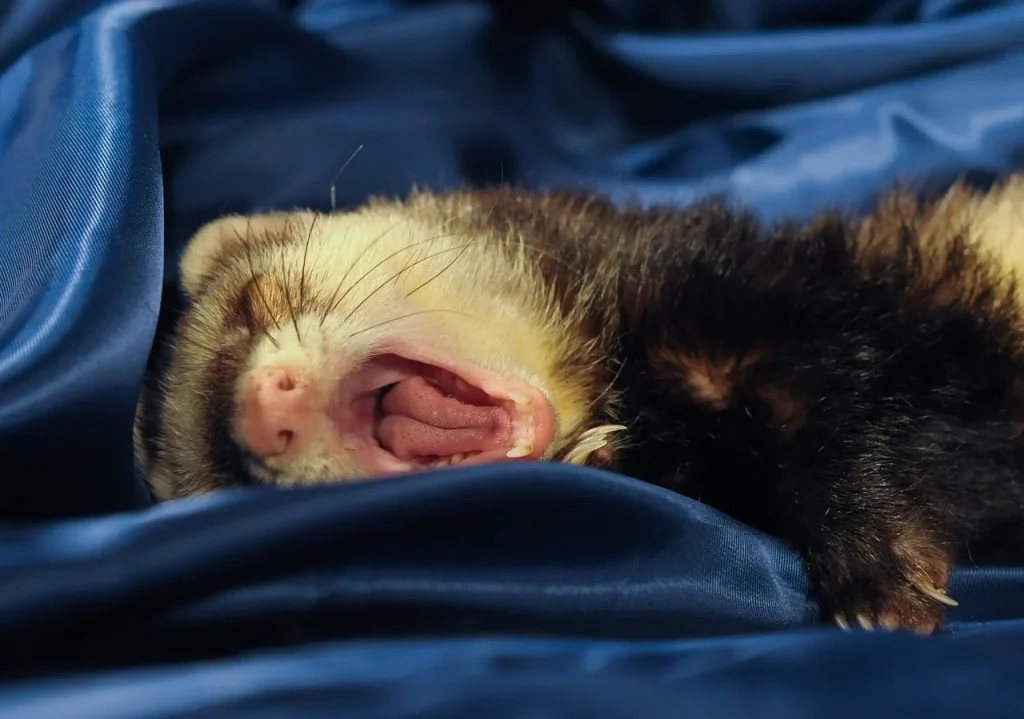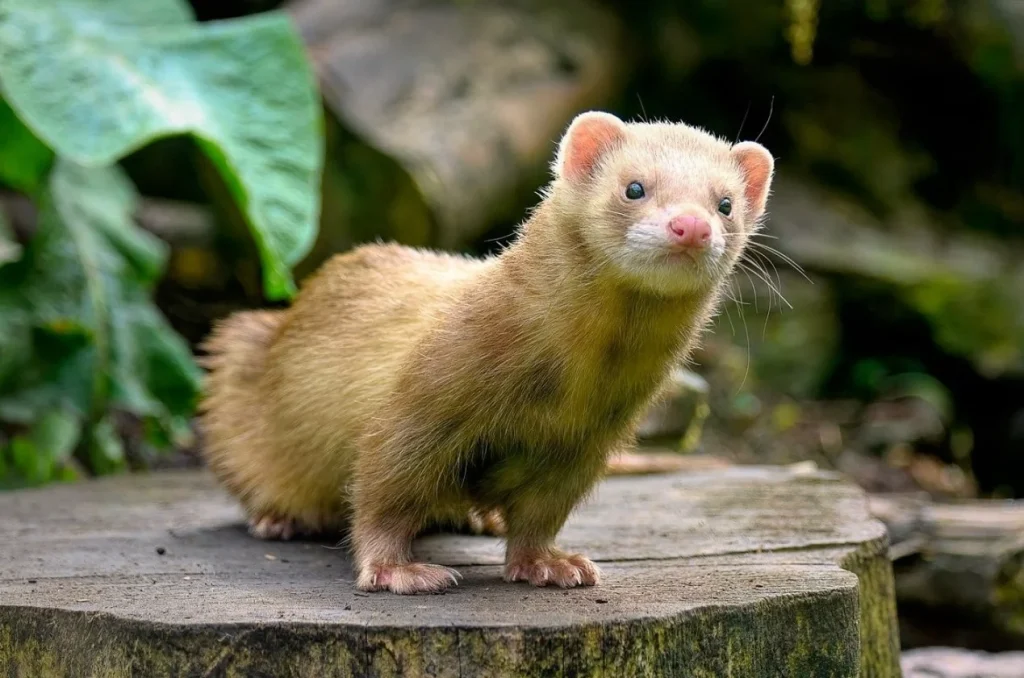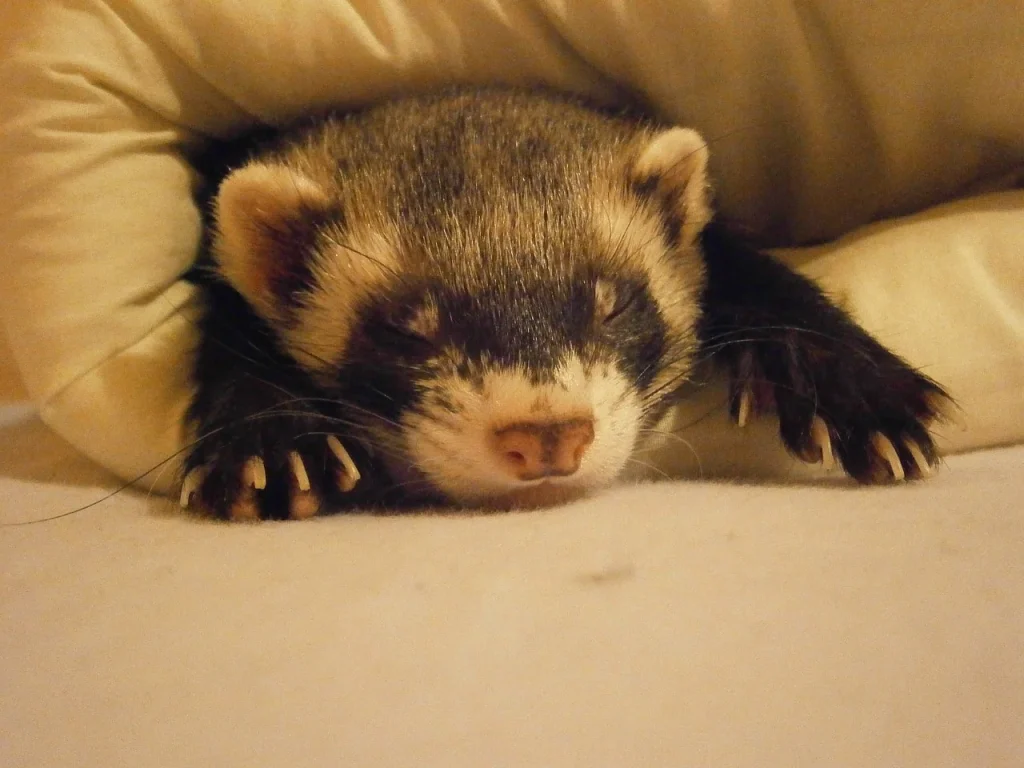Welcome to the world of ferrets! Did you know that ferrets are not just cute and lively pets but also have a rich history and some astonishing abilities? In this article, we ‘ll explore some fun facts about ferrets, shedding light on their intriguing lifestyle, dietary habits, and much more.
Whether you’re a seasoned ferret owner or simply curious about these little bundles of energy, you’re in for a treat as we unveil the secrets of ferrets’ lives.
The ferret offers a unique mirror to the human soul, one that reflects both mischief and joy.
Richard Bach
Ferret Facts
Get ready to explore the life of ferrets! Make sure to absorb every detail presented, as you’ll find a quiz at the end to challenge your understanding and confirm your status as a ferret expert.
- They are capable of bending their spine nearly in half, allowing them to turn around in very tight spaces.
- Their average sleep duration can be up to 18 hours a day.
- They can recognize their names and come when called.
- Their fur contains oils that give them a distinctive musky odor.
- Albino individuals lack pigment throughout their entire body, including their eyes.
- Their gestation period is around 42 days, one of the shortest among mammals.
- When excited, they perform a dance known as the ‘weasel war dance’, characterized by frenzied sideways hops.
- Historically, they were used to protect grain stores from rodents in ancient Egypt.
- They have binocular vision, with a field of vision encompassing 180 degrees.
- A group of them is called a “business.”
- Their heart rate can reach up to 400 beats per minute.
- Domestication of the species has occurred for over 2,500 years.
- They lack an ability to absorb nutrients from plants, making them obligate carnivores.

- Their lineage can be traced back to the European polecat.
- They are capable of passing through tunnels as small as 4 cm in diameter.
- Neutered males are known as gibs, while spayed females are called sprites.
- They can carry and hide away more than 100 items in their lifetime.
- A distinct feature of their skull is the shape of their braincase and elongation of the snout.
- They are known for their love of stashing various objects, especially shiny ones.
- Their adrenal glands are particularly prone to diseases, which can affect their health severely.
- They can learn simple tricks similar to dogs, such as sit and roll over.
- Their whiskers are used to gauge the width of tunnels and spaces as they navigate through them.
- Each individual has a unique pattern of fur, much like a human fingerprint.
- They can suffer from hairballs and gastrointestinal blockages, similar to cats.
- Despite their slinky shape, they are capable of bending and twisting their bodies to navigate complex burrow systems.
- Hearing is their most developed sense, and they can detect ultrasound frequencies used by rodents as communication.
- They are often employed in cable laying, pulling wires through long and narrow conduits.
- A lack of a particular enzyme prevents them from processing complex carbohydrates effectively.

- They have more cervical vertebrae than most other mammals, contributing to their flexibility.
- During play, they often perform a chuckling noise known as “dooking.”
- Despite their playful nature, they have a strong predatory instinct.
- Reproduction is stimulated by daylight, making breeding seasonally based on length of day.
- They can become overweight easily due to their ability to hide and store extra food.
- Melatonin implants are used by veterinarians to treat adrenal gland diseases in these animals.
- Their grooming habits are meticulous, similar to those of a cat.
- Under natural conditions, they can form complex social groups and maintain territorial boundaries.
- They use a variety of vocalizations to communicate, from hissing to squeaking.
- Insulinoma, a form of pancreatic cancer, is relatively common in older individuals.

- While wild individuals have a typical lifespan of 5 to 7 years, pets can live up to 10 years or more with proper care.
- They are one of the few animals capable of experiencing excitement-induced fainting, known colloquially as “ferret dead sleep.”
- Their spine contains 34 vertebrae, which is more than most mammals, allowing for exceptional flexibility.
- They have been featured in numerous books and movies as symbols of cunning and agility.
- When hunting, they are capable of pursuing prey into underground burrows.
- Black-footed variants are a critically endangered species native to North America.
- Research has shown that they use magnetic orientation to navigate when exploring.
- Their populations are threatened by habitat loss, disease, and decreased genetic diversity.
- They are highly susceptible to human influenza viruses, which can be fatal if not properly managed.
- Some cultures consider them to bring good luck and fortune.
- Distinct from their wild ancestors, domesticated forms have a more docile temperament.
- They have been trained by some wineries to chase rabbits away from grapevines, serving as eco-friendly pest control.
Ferret Myths

Having covered the facts, it’s time to address some widespread myths. Let’s distinguish what’s true from what’s merely a myth.
- Ferrets Are Wild Animals
It is often believed that they are wild creatures; however, they have been domesticated for over 2,000 years. They are typically friendly and enjoy human companionship, making them popular pets. - Ferrets Do Not Require Much Attention
Contrary to this belief, ferrets are highly social animals and need significant interaction with their owners. Regular playtimes and interaction are required to keep them happy and healthy. - Ferrets Can Be Fed Cat Food
While cat food is sometimes given to ferrets, it is not advisable. Ferret-specific food is recommended because it meets their unique dietary needs, which include high protein and fat levels with very low carbohydrates. - Ferrets Don’t Smell
It is often mistakenly thought that ferrets are odor-free pets. In reality, ferrets have scent glands that produce a musky odor. Regular cleaning and proper care can minimize this scent but not eliminate it entirely. - Ferrets Are Nocturnal
Although many believe ferrets to be nocturnal, they are actually crepuscular, meaning they are most active during dawn and dusk. Their activity patterns can often be adjusted to match those of their human families.
Ferret Quotes

Here are five famous quotes about ferrets. Feel free to share more in the comments so I can add them to the list as well.
Ferrets are not just pets; they are an attitude.
Jeanne Carley
Jeanne Carley, a renowned ferret photographer, encapsulates the distinct personality traits that make ferrets more than just pets.
To understand a ferret, you must be part ferret yourself.
Joanne Rowling
Joanne Rowling, the famed author, suggests that embracing the ferret’s curious and energetic traits helps in forming a bond with them.
Ferrets teach us that taking life too seriously is a fool’s errand.
James Herriot
James Herriot, a veterinarian and writer, admired how ferrets demonstrate the importance of fun and playfulness in life.
In the eyes of a ferret, every closed door is simply a challenge to be overcome.
Mike Harding
Mike Harding, a comedian and author, humorously captures the determined and inquisitive nature of ferrets.
If you want loyalty, get a dog. If you want entertainment, get a ferret.
Anonymous
This anonymous quote contrasts the differing appeals of dogs and ferrets, emphasizing the entertaining antics of ferrets.
Ferret FAQ

As you move into the final section before our quiz, take a moment to focus on the upcoming FAQs.
- Can ferrets swim?
Yes, they can swim. They have a natural ability to paddle in water, but whether they enjoy it can vary between individual ferrets. Some may find water play delightful, while others prefer to stay dry. - Are ferrets nocturnal?
They are not strictly nocturnal; they are crepuscular, which means they are most active during the dawn and dusk hours. They adapt well to the schedules of their human families, often matching their active times. - Can ferrets see in the dark?
They have decent night vision but it’s not as sharp as some other nocturnal animals. They rely more on their keen senses of smell and hearing to navigate and explore in low light conditions. - Will ferrets kill each other?
They usually don’t kill each other. They are social animals that often enjoy the company of other ferrets. However, like any creatures, they can become aggressive if not properly introduced or if they feel threatened. Supervision and proper introduction are key when bringing new ferrets together. - Are ferrets good pets?
They can be wonderful pets for the right person. They are playful, curious, and affectionate. However, they require a lot of care, regular playtime outside their cage, and a safe, ferret-proofed environment. They’re great for those who can invest the time and energy into their well-being.
Ferret Trivia

Jump into our fantastic ferret quiz! Fail to answer correctly, and be prepared to have your favorite shoes turned into a ferret’s new hideout!
Conclusion
Finally, owning a ferret is both a joy and a challenge. These energetic little beings are full of surprises, always ready to explore and play. With the right care, a ferret can be a delightful addition to your family, offering laughter and companionship.
Keep learning about their needs, and enjoy every moment with these extraordinary animals. Till the next time, stay curious and explore more. Cheers.


